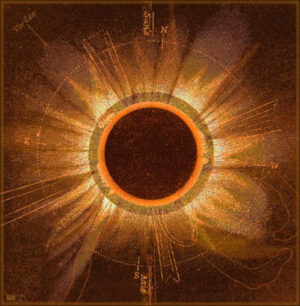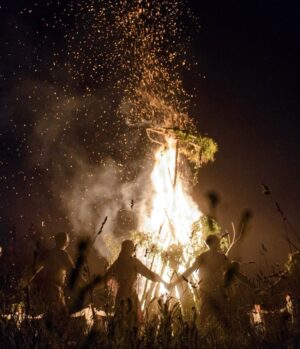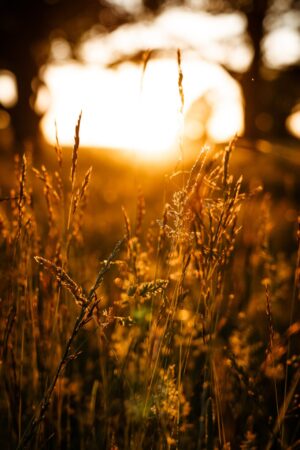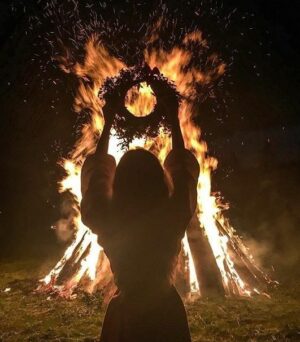Litha, also known as Midsummer, is a widely-observed pagan celebration that many historians believe has been practiced for thousands of years. One of four Celtic fire festivals, Midsummer or the summer solstice is a sabbat all about celebrating the sun. In the northern hemisphere, this sabbat is observed on either June 21st or 22nd, and on December 21st or 22nd for the Southern hemisphere.
I feel that pagan holidays should be celebrated in ways that are fun and accessible to practitioners of all walks of life, while still honoring the beautiful traditions from which these celebrations sprang.
With that in mind, let’s talk about how to celebrate the Summer Solstice and help you find the perfect rituals to craft your own Litha holiday traditions!
What Is Litha?

Litha marks the middle of summer, hence the name Midsummer. It has the most hours of daylight out of any other day in the year. The word solstice translates roughly to “sun stands still”, and refers to the appearance of the sun hanging endlessly in the sky during this time. As a result of the extended daylight hours, midsummer nights are subsequently the shortest.
During Litha, we take time to greet the Sun at its highest point in the sky. Flowers are blooming brightly, insects are humming busily along, and the fae lurk our realm freely as the Earth basks in the warm glow of the summer sun.
Much like when the moon reaches its fullest and thus begins to wane, the sun echoes a similar energy at this time of year. It’s time to prepare for the shortening of days. Week by week, the sun will begin to set sooner, and we’ll have less and less time to prepare for the bitterness of the colder months. While it’s a time of celebrating the blessings that we have, the summer solstice is an acknowledgement that it will not always be so.
In the battle of light and darkness, the Oaken King of lore is at his prime during Midsummer, raging steadily forward in his ongoing battle with the Holly King of the colder months. Soon, the harvest time will come, and we will need all of the Sun’s energy to prepare.
The Meaning Of Litha:
Because the high point of summer has been viewed as such a significant date by societies all over the world since recorded history, it’s easy to see why this celebration is such a big deal! The history of these events is varied, creating a colorful mosaic that has evolved into the festival that we celebrate today.
It is an incredibly significant holiday on the pagan Wheel of the Year, marking the largest of the fire festivals. As soon as the Sun enters the sign of Cancer, the season of Midsummer begins. It is the longest day of the year – meaning that the day has the most hours of sunshine than any other calendar day.
In Wiccan tradition, the goddess is pregnant at this time, so this season is great for celebrating women, the mother archetype, fertility, pregnancy, and childbirth.
It is also a powerful time for spells, rituals, and deity work. Plants and hers are at their highest power and potency, so plant magic performed during this time is likely to reap those benefits. The sun is at its greatest point of power as well, lending its energy to solar magic and creating a lovely atmosphere to enjoy all of nature’s wonders.
How To Pronounce Litha
Before we dig into the good stuff, like Midsummer traditions and Litha rituals to try, let’s take some time to make sure we’re pronouncing everything right.
The proper pronunciation for Litha is Lee–thuh. In this word, the i is spoken as a long ē sound, as in leaf or piano.
With this noted, I’ve heard many say it just the way that it looks. From my understanding, this is also an accepted pronunciation. Just have fun and be respectful to others who may be at different points along their journey of learning.
How To Celebrate Litha
As one of the most important sabbats on the pagan calender, the Summer solstice is a time for festivities and merriment. Bonfires were commonly held to celebrate, but there are deeper meanings behind each of the rituals we’ll talk about today.
Typically, Litha traditions revolve around these motives:
- Fire
- The Sun
- Fertility
- Childbirth
- Power
Midsummer Rituals:
Because this is such a popular celebration worldwide, there are rituals from many different walks of life that you can use to create your own traditions.
Whether you’re a solitary practitioner or looking for ideas to get your whole family, neighborhood, or coven involved in Litha, here are some of our favorite to help you get the ball (erm…wheel?) rolling!
12. Prepare A Midsummer Feast
For this friendly meal, you can choose to prepare spicy foods that embody the bold power of the sun, fresh fruits and vegetables from your garden, or savory dishes cooked with herbs picked at the peak of freshness – and even wash them down with a pint of mead!
The beauty of this celebration is that it can be as subtle or in-your-face as you want it to be. If you’re in the broom closet, nobody needs to know the reason behind your summer get-together. Just invite the friends and family over for a nice meal!
Alternatively, you can host a Litha potluck for your neighborhood. Bonus points if you combine it with our next activity.
11. Host A Summer Bonfire

This is perhaps the OG Midsummer celebration: To honor the power and warmth of the Sun, we create bonfires in its image. This tradition has been practiced by a multitude of cultures around the world during Midsummer for thousands of years. In fact, it’s the largest fire festival on the pagan wheel of the year.
If you can’t find a bonfire in your area to join, a summertime campfire will do!
10. Hold A Solitary Candle Ritual
If you’re more of a solitary practitioner or need to know how to celebrate Litha in the broom closet, a simple candlelight vigil paired with some thoughtful meditation is a great low-key way to honor the sabbat.
9. Watch The Sunset & Sunrise

As the shortest night of the year, many witches like to watch the sunset at night, then stay up to watch it rise again in the morning.
This is another easy ritual for solitary witches or even couples who are looking for romantic ways to celebrate the summer solstice.
8. Burning The Wheel
In this Irish tradition, townsfolk would come together to celebrate in this unique ceremony. They would bring straw from each family home and add it to a pile. The community straw was added to a large wheel placed at the top of a steep hill.
At nightfall, the townsfolk would return to watch the men of the village light the wheel on fire and steer it down the hill. (You’ll notice that setting things on fire was a common theme for Midsummer shenanigans.)
During the celebration, the men and boys of the village would hold high their torches (crafted with community straw) to keep the wheel alight as it sped downward.
The flaming wheel in this practice represents the Sun. As it spins wildly down the hill, it gathers oxygen and burns up faster and faster. Their ultimate goal was to plummet the wheel into the Moselle river. If they succeeded, the village would be blessed with an abundant harvest for the year.
I’m not saying it’s a safe activity, but it is a wildly interesting tradition that you could recreate in a symbolic way, with a much smaller wheel. Safely.
7. Make Floral Wreaths Or Crowns

Another age-old tradition is making wreaths using flowers that are local to your area. If you’re looking for something on a smaller scale, floral crowns are super easy to make. You can even incorporate bright ribbons that correspond with the colors of Litha!
6. Work With The Fae

During the solstice, the veil between worlds is incredibly thin. The fae tend to cross over during this time to participate in the battle between the Holly and Oak kings, so they are out in numbers. It’s for this reason that many pagans and witches who work with the fae like to do so on this holiday. You can reach out to them by building fairy gardens or leaving offerings.
I would advise researching simple precautions to take before trying to work with them directly though – the fae can be tricksters, to say the least.
5. Enjoy The Summer Sun

Honor the Sun and the Earth by spending time outdoors. It is summertime, after all! Soak in the warmth, enjoy some meditation while sunbathing, or take a hike! Read on for another idea that will get you spending time under the sun.
4. Go Swimming Or Enjoy The Water

Did you know that Litha is also a great time to celebrate and honor the element of water? While honoring goddesses of fertility, we acknowledge the realm of water, which is a shared domain to many of them. So hop in the pool, set up your sprinkler, or craft a homemade slip ‘n’ slide, if you dare!
3. Harvest Herbs

Herbs are at their freshest during this time, so take some time off this weekend to do some harvesting, pickling, or baking. You can then use the herbs in your spells and recipes, or share them with friends and neighbors.
2. Harness The Sun’s Power With Solar Magic

With the sun at its very brightest during the summer solstice and the veil incredibly thin, we are presented with the perfect opportunity to perform solar magic or harness the sun’s energy at its peak. It is a great time to make sun water, use sunflowers or dandelions in your spells, or make offerings to sun-related deities.
1. Decorate Your Altar For Litha
During Midsummer, we honor gods and goddesses of the sun and those that represent fertility, so feel free to make a special place on your altar for Sol, Ra, Juno, or your favorite deity. You can create statues, art, or poetry to honor these entities.
In addition, you can include any symbolism that you associate with Litha. Check out some ideas below!
Litha Symbolism
Litha symbols can include any deities that you worship or work with during this time (consider archetypes of fertility and power), however, there are other more specific symbols that you can employ if you want to do a ritual or spell on Litha. Here are some of the most common Litha symbols.
Colors: blue, green, pink, purple, yellow (the brightest hues in nature)
Crystals: emerald, lapis lazuli, peridot
Herbs: Elderflower, fern, rose
Altar Decorations: Sun Wheels, flowers, statues of fertility gods or sun-related deities
Associations: Bonfires, fire (in general), water, oak, fertility
More Information On Litha:
The Merry Month Of June
As you know, Litha occurs in June, but did you know that the solstice falls within the month of oak on the Celtic tree calendar?
It’s also during this month that the Oak King of mythology is in his greatest power, but that isn’t the only deity with ties to the month. June is affectionately named after none other than the Roman goddess of fertility, Juno.
St. John’s Day
Beginning in 15th century Ireland, the Midsummer celebration has been Christianized as St. John’s Day or St. John’s Eve, which occurs on June 24th. Some Christians celebrate this holiday as a feast day for John the Baptist.
It marks the birth of St. John to Elizabeth, who was the cousin of the Virgin Mary. When Mary learned of her pregnancy from the angel Gabriel, he told her that her cousin was also pregnant, and already six months along. Thus, John would be born exactly six months before the birth of Christ.
In Florence, Italy, fanciful parades are held during Midsummer, but this celebration was once far more lavish. Traditionally, Florencians would host elaborate plays to act out the noble tale of St. John. They would still hold parades, of course, but the night would end with an extravagant fireworks display.
In some communities, bonfires would be lit to ward off dragons from attacking villagers and poisoning their rivers and wells. Whether that’s true or not, can we just normalize throwing bonfires for the sake of having bonfires? Okay, cool.
Today, baptisms are commonly held on St. John’s Day. In some communities, candlelight vigils are hosted in place of traditional torch-bearing ceremonies. In these processions, the light of the torch represents the “shining light” that is John the Baptist, whose arrival heralded that of Jesus Christ.
Vestalia
In ancient Rome, Vestalia would be held in June around the time of the summer solstice to pay tribute to the goddess Vesta (or Hestia, to the Greeks).
The celebration lasted from June 7th to 15th and allowed female worshipers of the goddess to make offerings at her temple. Families would light a hearthfire in Vesta’s honor and dedicate prayer and songs to the goddess to invite her warmth and blessings into the home.
I hope this gives you ideas for Litha traditions, rituals, and new ways to celebrate this wonderful Sabbat with your friends and family!


